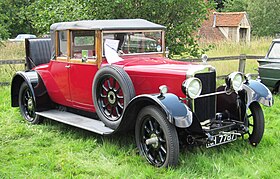Talbot 14-45
|
|
|---|---|

14-45 drophead coupé with dicky by (unknown) registered May 1927
|
|
| Overview | |
| Manufacturer | Clément-Talbot Limited Kensington London W10 |
| Production |
|
| Model years | 1932–1935 |
| Assembly | North Kensington London |
| Designer | Georges Roesch |
| Body and chassis | |
| Class | luxury |
| Body style |
|
| Layout | FR |
| Powertrain | |
| Engine | 1665 cc Straight-6 |
| Transmission | AX preselector gearbox |
| Dimensions | |
| Wheelbase |
|
| Length | 175 in (4,445 mm) |
| Width | 68.5 in (1,740 mm) |
| Kerb weight | Saloon 23½ cwt, 2,632 lb (1,194 kg) |
| Chronology | |
| Predecessor | Talbot 12-30 |
| Successor | none |
| Designer | Georges Roesch |
|---|---|
| Combustion chamber | |
| Configuration | Straight 6-cylinder |
| Displacement | 1,665 cc (101.6 cu in) |
| Cylinder bore | 61 mm (2.40 in) |
| Piston stroke | 95 mm (3.74 in) |
| Cylinder block alloy | cast iron. 4-bearing disc-webbed crankshaft |
| Cylinder head alloy | detachable |
| Valvetrain | overhead valves |
| Combustion | |
| Fuel system | Smith's carburettor |
| Cooling system | thermo-siphon, flywheel fan |
| Output | |
| Power output |
|
The Talbot 14-45 also known as Talbot 65 is a luxury car designed by Georges Roesch and made by Clément Talbot Limited in their North Kensington factory and usually bodied by fellow subsidiary of S T D Limited, Darracq Motor Engineering in Fulham.
The six-cylinder engine is just over 1½ litres at 1665 cc. The inlet and exhaust manifolds are bolted together and fitted to the left hand side of the block with the 5-jet carburettor bolted to the front end of the inlet manifold. Petrol is delivered from a vacuum tank on the dash supplied from a 14-gallon tank at the back of the car. The overhead valves are operated by pushrods with double valve springs. The rockers must be kept in position if the detachable cylinder head is to be removed. There is forced lubrication throughout the engine. All six cylinders are cast in one piece along with the top half of the crankcase.
Sparking plugs, distributor and contacts are on the right side of the engine block. Ignition advance and retard is entirely automatic. A dynamotor (combined dynamo and starter motor) is fitted at the front end of the crankshaft. Engine timing (camshaft) is turned by gear from the crankshaft
Cooling water passes through a honeycomb radiator and the airflow is assisted by a fan embodied in the engine's flywheel. Circulation is by thermo-siphon there is no water-pump.
Clutch and gearbox are bolted firmly to the engine block, gears are changed by a lever beside the driver's right hand operating in a gate. The clutch is not fully enclosed. Drive is carried to the rear axle by an enclosed propellor shaft. Spherical and universal joints are automatically oiled, there is a central bearing in the torque tube. Final drive is by spiral bevel and the axle is of the half-floating design.
Steering is by a worm and nut system, its box raised to give a comfortable rake to the steering wheel. There are just the four brakes, one on each wheel . They are not compensated. The brakes are operated by rods. There is a hand lever by the driver's right which controls the rear brakes alone. The aluminium brake shoes are adjusted for wear by a wedge which opens or closes a fulcrum on one end of the shoe. The brake drums are enclosed.
The springs are quarter-elliptical each with a shackle at its rear. At the front of the car they are set without camber, held out of centre and slightly inclined to the rear and are fitted with snubber leaves. Shock absorbers are fitted all round.
When trying out this relatively expensive 5-seater tourer the correspondent of The Times reported he thought the car's design had much to recommend it but could be improved. A four-door five-seat car it is comfortable but the front cushion tends to obstruct the front door. The seat is adjustable. He noted the test car had already travelled 8,000 miles. Its high-speed type engine with only four bearings, he said, is remarkably smooth, it runs sweetly up to 4,000 rpm yet picks up easily in top from almost a standstill. Over 55 mph increased speed takes time to build. The indirect gears were noisy. Except for some clutch slip when climbing hills under a heavy load all controls worked well and smoothly. He also reported that the suspension let the car bounce too much suggesting slacker tyres and softer shock absorbers might be a useful improvement.
...
Wikipedia
